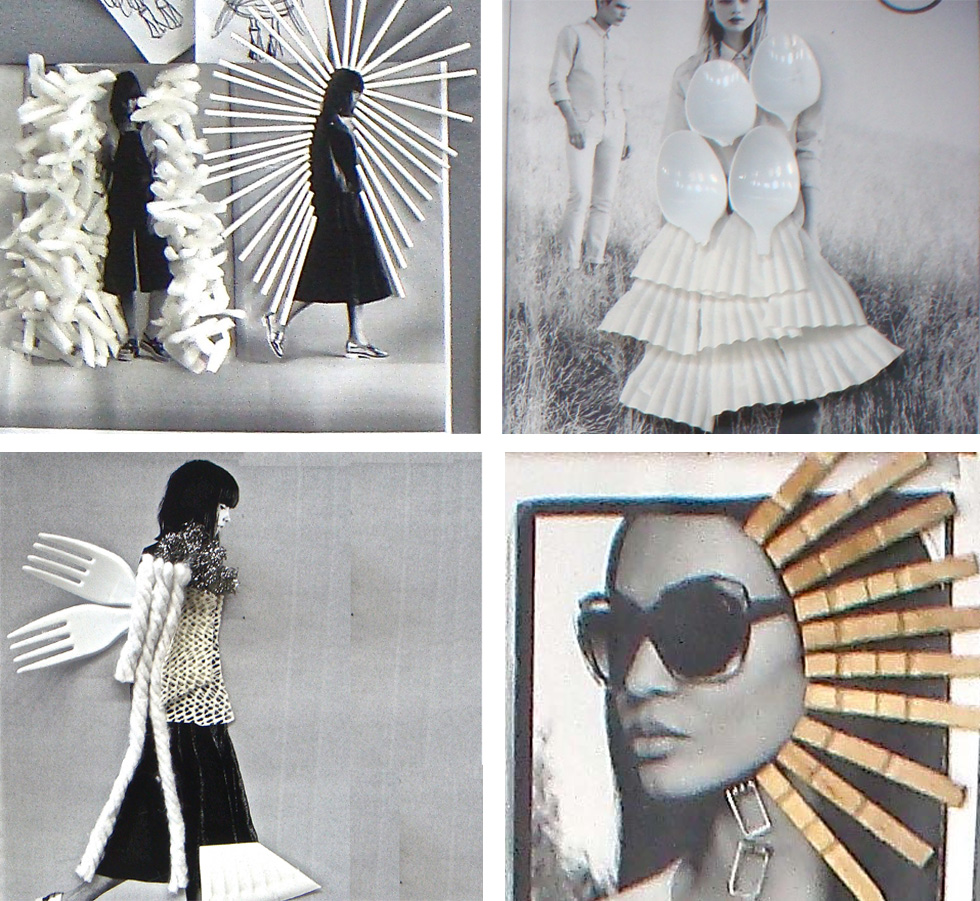by Rebecca Barton
Using single use plastics and everyday objects found around the home, create a series of innovative garment and costume designs.
Don’t forget to submit your favourite fashion silhouette that you create or post online and tag @natsatclub and @raveoutreach
Overview
Fashion designers use a range of processes and methods in order to develop clothes designs. At the top level this can include creating collages, rough sketching and working on a stand. This fun activity introduces aspects of design development as well as producing work suitable for a creative portfolio.
Sustainable Fashion – Fashion as Statement
There is a growing market for sustainable / slow fashion. More people are beginning to buy second hand clothes and indeed recycle and customise their existing garments. Alongside this, activists such as Greta Thunberg have made us all aware of the issues surrounding single use plastics and the environment, and the Extinction Rebellion movement has galvanised the young to stand up and protest about these issues.
Facts about single-use plastics
- Single-use plastics accounts for half of all plastic thrown away
- Worldwide, 500 billion disposable cups are used every year
- 500,000 single-use plastic straws are used every single day
- 32% of the 78 million tons of plastic packaging produced makes its way into the ocean every year
- Around the world, 4 trillion plastic bags are used every year.
- Even though most supermarkets offer plastic bag recycling, only 1% of these bags are recycled.
Materials needed

- You can use a varied range of objects. These might include paper cups, plastic cutlery, paper plates, clothing pegs, plastic bags, plastic straws, bottle lids, doilies, washing sponges, scourers, cotton buds, etc.
- Some magazine fashion figures – you can print these out from the internet if you don’t have any magazines, or you can draw from your screen if you don’t have a printer. Alternatively, use photos of your family.
- You could also use a stapler, scissors, masking tape, glue or dressmaking pins. If you don’t have these then you can just place items on the image and then take a photo
Activity part one – Fashion Silhouettes
Using the objects you have gathered, make 5 collages, creating exciting fashion silhouettes. Glue them down when you are happy.
Don’t worry if the garments don’t look wearable – the braver the better!
REMEMBER… record your process, that way you will have lots of ideas as well as the 5 you select
- Consider decorating the space around the body, this will give you interesting new shapes
- Use more than one type of object in a design – consider using hard and soft objects together
- Experiment with focusing on one area of the body
- Think about how you might develop the idea further, either in sketches or on the stand

Activity part two – Scaling Up
This task asks you to recreate and refine your initial ideas but at a larger scale. This will challenge you to think how your design works around the entire body. It will also allow you to consider construction.
- If you have access to a printer or photocopier, photocopy (or take a photo then print) a selection of objects. Consider enlarging the size. Print several at once and duplicate the image x 3
- Cut out the photocopies and pin them onto the stand (or a willing model) along with your materials. Using the same images, recreate 3 different styles.
REMEMBER… to photograph your work continually.

Further Development
The first two activities should give you an idea about scale, pattern, silhouette, and construction, however they should be seen as starting points only. Further development could include making garments and accessories with the household objects or sketching from the work on the stand to develop it into feasible garments.
Thank you for taking part in the Ravensbourne University London Art&Design Saturday Club Workshop.
Submit your favourite fashion silhouette that you’ve created and photos or your creation on the model or post online and tag @natsatclub and @raveoutreach
Resources & References
Designers who are at the forefront of sustainable fashion:
Activist websites:
Contributed by Rebecca Barton, Ravensbourne University London Art&Design Saturday Club
Rebecca has worked as for several companies as a freelance womenswear designer, specialising in womenswear tailoring, but also more recently resort wear. Clients have included Mulberry, River Island, Kookai, Albeni.
“It’s been great to work with such a friendly and enthusiastic group of young people who have shown their genuine love, talent and commitment to learning about the fashion industry.”